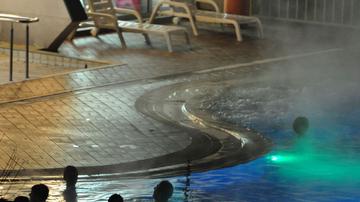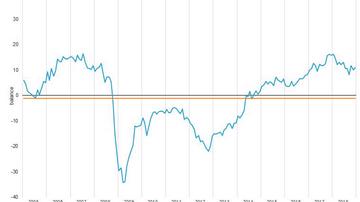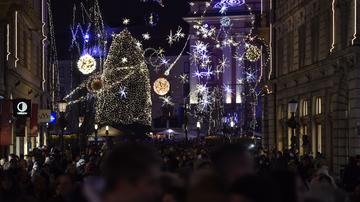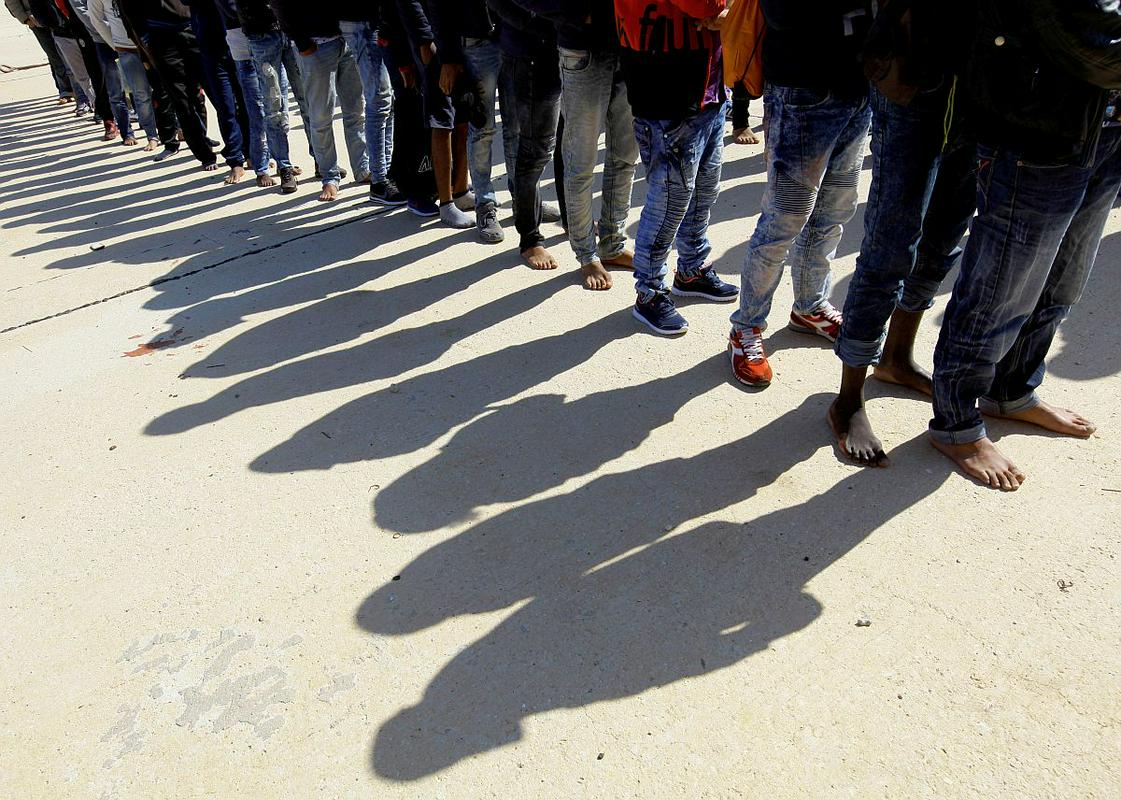
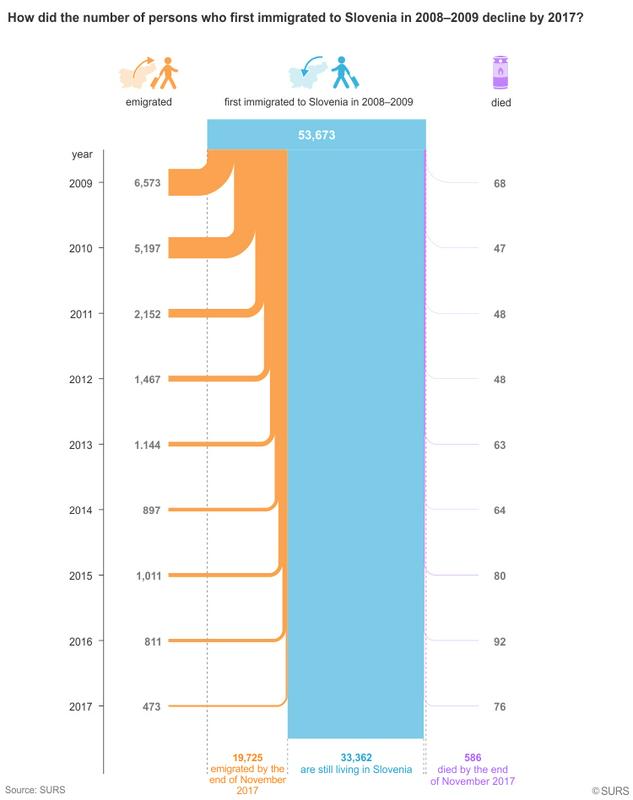
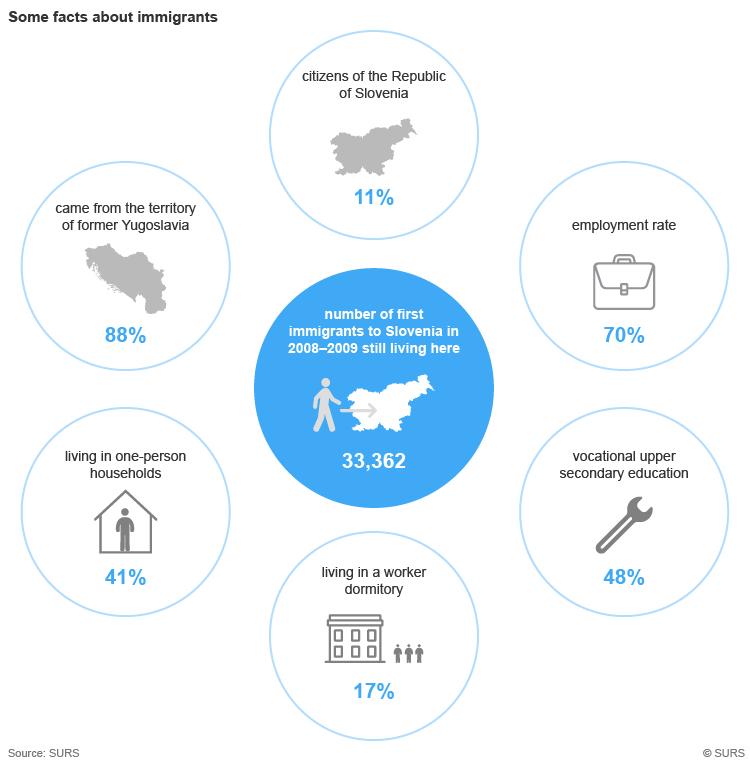
The International Migrants Day was proclaimed in 2000; 18 December was selected in memory of the adoption by the United Nations General Assembly of the International Convention on the Protection of the Rights of All Migrant Workers and Members of Their Families on 18 December 1990. In 2007–2009 the highest immigration in the history of Slovenia was recorded (30,000 on average annually). Almost 54,000 (93%) persons immigrated to Slovenia in 2008–2009 for the first time (average age 32 years); 7% were so-called re-immigrants and they were on average 7 years older.
In November 2017 there were 33,362 persons living in Slovenia out of 53,673 who first immigrated to Slovenia in 2008–2009. Nearly 600 of those immigrants died in Slovenia after immigration. Almost 20,000 of them emigrated, 60% in the first two years after immigration. The longer they live in Slovenia the less likely it is that they will emigrate. More men emigrated (four out of ten) than women (one in four).
Most people who immigrated to Slovenia after independence are foreign citizens from former Yugoslavia. Immigrants from 2008–2009 also follow the rule; over 90% of them were foreigners, among first immigrants 95%. Continuous long-lasting living in Slovenia and some other personal circumstances (such as being married to a citizen of Slovenia) are preconditions for acquisition of Slovenian citizenship. 2,600 (5%) foreigners acquired citizenship, 85% of them are still living in Slovenia. So citizenship of the host country is the factor with negative influence on further international mobility.
Unemployment rate for immigrants from 2008–2009 is increasing
30,300 immigrants still living in Slovenia were 15 or more years old at the time of first immigration. In general a high employment rate is typical for immigrants. On 1 January 2016, 70% of immigrants from 2008–2009 were employed, which is 23 percentage points more than the population of Slovenia. Longitudinal data from 2011 to 2016 (6 consecutive years) show that almost half of immigrants were employed all the time, and that an additional third of the immigrant stock were employed at least three years. Only 8% of first immigrants were inactive the whole period. An indicator of the worsening of their socio-economic situation is the registered unemployment rate, which was 6.2% in January 2011 (6.1 percentage points below the Slovenian average) but in 2016 reached 14.7%; this was above the Slovenian average, which was only slightly higher than five years before (12.9%).
Better education is an important factor of the integration of immigrants
Educational attainment of persons who first immigrated to Slovenia in 2008–2009 is on average lower than educational attainment of the whole population. At the beginning of 2016 only 7% of immigrants aged 25 years or more had tertiary education; for the whole population the share was 24%. However, it is important to point out that one in four immigrants aged 15 or more improved the education after immigrating to Slovenia. This is not true only for the younger population at the time of immigration included in regular educational system but also for persons aged 20 years or more at the time of first immigration to Slovenia. There is a strong connection between attaining tertiary education and acquiring Slovenian citizenship: one in five immigrants with foreign citizenship who attained tertiary education in Slovenia is now a citizen of Slovenia. Better education is an important factor of the integration of immigrants into a new social environment.
One in six immigrants from 2008–2009 lives in a worker dormitory
Immigrants are as a rule more mobile than the native population. Besides, they often reside (at least at the beginning) in collective living quarters such as worker dormitories. An important factor with negative influence on mobility is ownership of dwelling and residing in owner-occupied dwellings. All these facts are valid for first immigrants from 2008–2009. Only 23% of them are still living at the same address. So their mobility rate is 77%; for the total population in the same period 24%. On 1 January 2017 around 5,500 (every sixth) immigrants were living in worker dormitories, 2,500 of them the whole period since immigration. On 1 January 2015 fewer than 5,000 immigrants (17.5%) were living in owner-occupied dwellings (81% of occupied dwellings in Slovenia are owner-occupied).
Every other household with immigrants from 2008–2009 is a one-person household
According to the 2015 register-based census there were 27,000 private households with 33,000 immigrants from 2008–2009. They were living together with 14,000 immigrants from other years, 10,000 descendants with at least one foreign-born parent and 3,800 native-born without immigrant background. As there are only 6% of native-born without immigrant background living together with persons with immigrant background after 8 years, we can speak about inadequate integration of immigrants. Every other household with immigrants from 2008–2009 is a one-person household (93% of them are male one-person households). Due to such a high share of one-person households, the average immigrant household size is 2.26 (Slovenia 2.47). If we exclude one-person households, the average immigrant household size is 3.47, which is relatively much higher than the Slovenian average (3.18).
A typical immigrant from 2008–2009 still living in Slovenia
The most typical immigrant from 2008–2009 is a man living alone (12,400), with permanent residence in Slovenia (84%) in one of the urban municipalities of Slovenia (53%), having citizenship of a country from former Yugoslavia (95%), employed (81%), with vocational upper secondary education (62%), and aged 30–39 years (35%).





















































